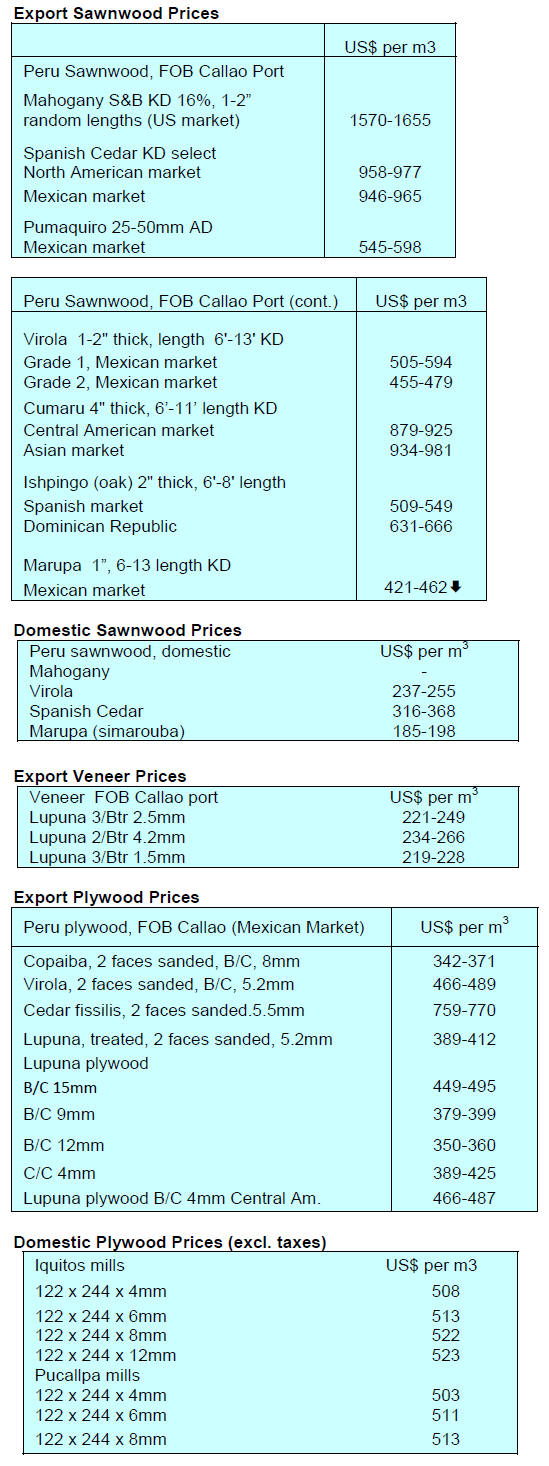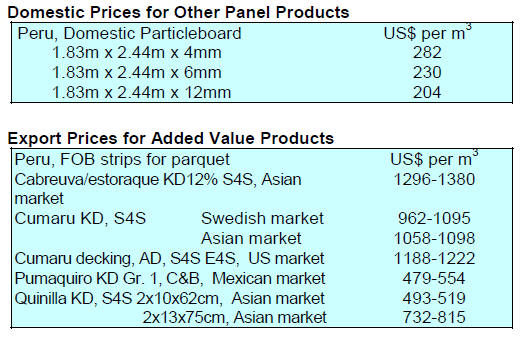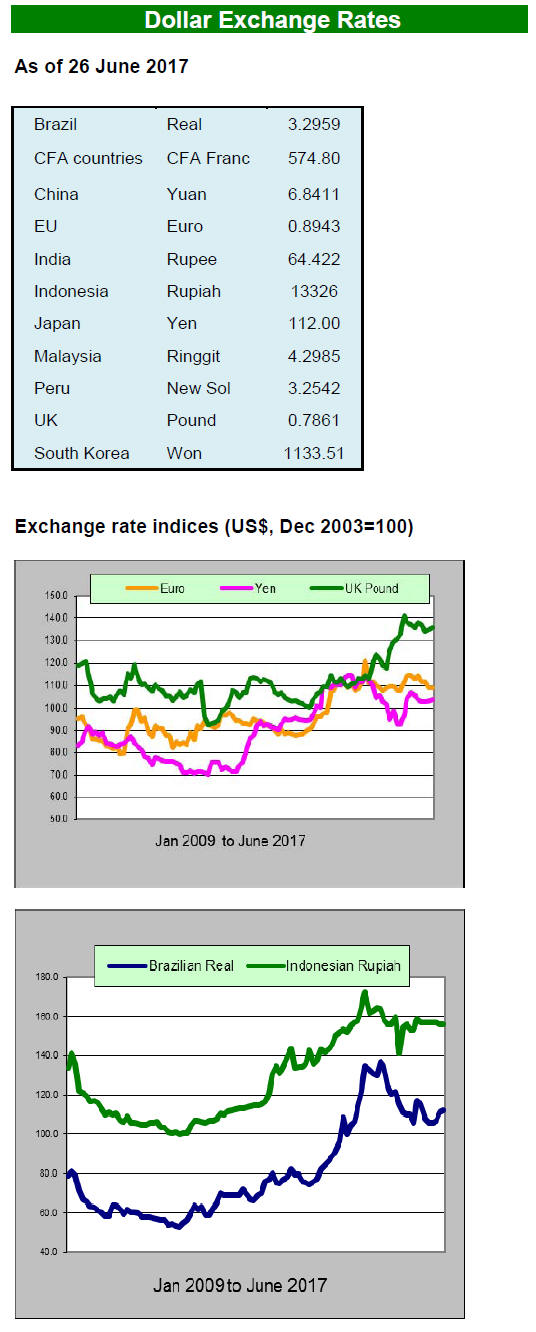2. GHANA
First quarter exports down 21%
Data from Ghana’s Timber Industry Development
Division (TIDD) shows that wood product exports in the
first quarter 2017 totalled 72,533 cu.m compared to 92,314
cu.m for the same period in 2016, a 21% decline.
Export values in the first quarter 2017 were also down by
around the same amount. The decline in exports was
observed for all major wood products.
The main exports in the first quarter 2017 were air dried
sawnwood, kiln dried sawnwood, plywood, billets and
sliced veneer.
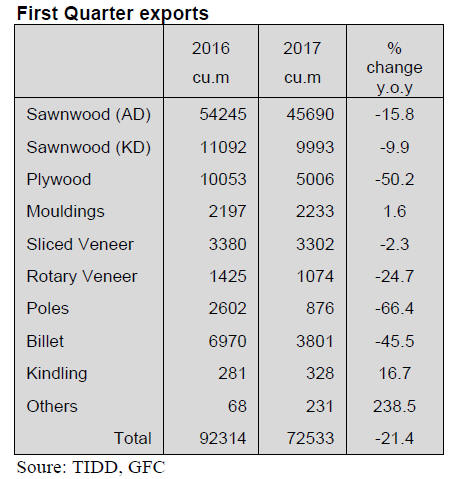
In the first quarter overland exports of plywood and
sliced
veneer were 4,547 cu.m and 32 cu.m respectively. There
were no exports of sawnwood to neighbouring countries in
the first quarter. Primary products accounted for 6.5% of
first quarter exports, secondary products accounted for the
bulk of exports (at 90%) with the balance being tertiary
product exports.
The main species exported included papao/apa, wawa,
teak, ceiba and senya.
Ghana continued to maintain its major markets. Only the
US and Middle East registered increased imports of wood
products from Ghana in the first quarter of 2017 against
that of 2016. Exports to all other markets declined.
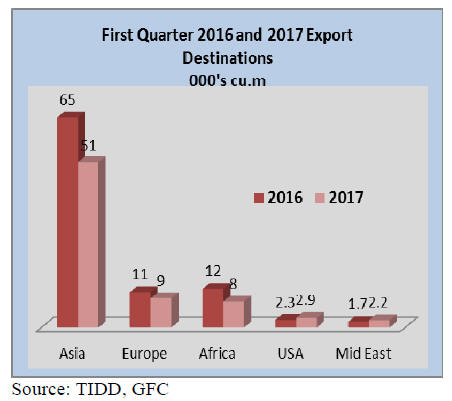
UK-Ghana Trade and Investment Forum
The Ghana Investment Promotion Authority (GIPA) and
the UK-Ghana Chamber of Commerce (UKGCC) held a
UK-Ghana Trade and Investment Forum 2017 on 28 June.
The Forum which aimed to attract foreign investments
from UK businesses provided the first initiative on
investments by Ghana’s new government.
Senior Minister, Yaw Osafo-Maafo, lead the Ghana
delegation which included businessmen to discuss topical
issues aimed at building upon the strong economic
relationship between the two countries. The UK is one of
the leading markets for Ghana’s wood products.
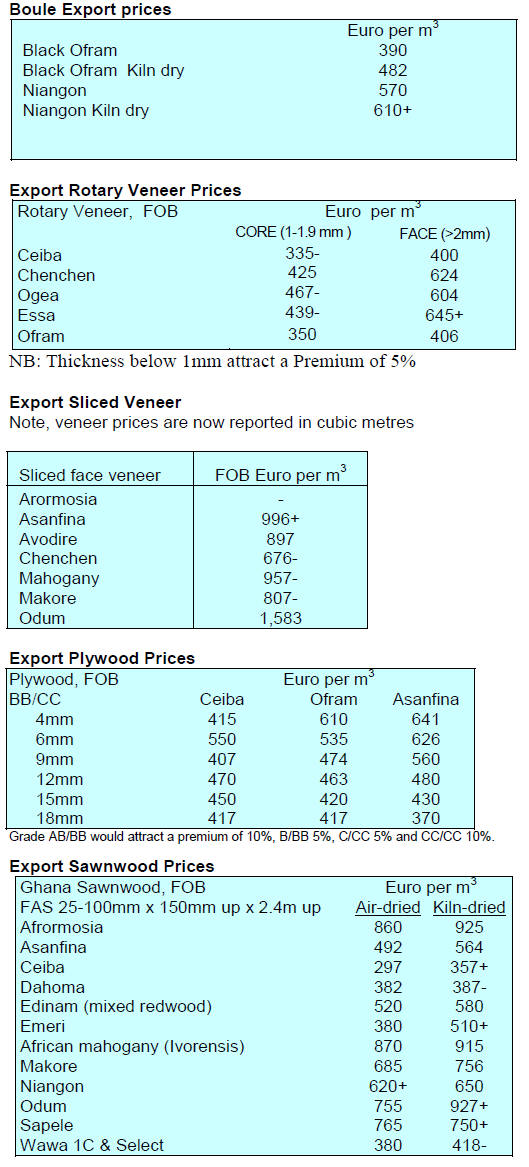
3.
SOUTH AFRICA
Steep decline in business confidence
The domestic media in South Africa are reporting the
latest RMB/BER Business Confidence Index (BCI) which
shows business confidence at a low last seen during the
2009 recession.
Analysts write that the decline in sentiment is about more
than the increased political uncertainty as the current
downswing began more than 3 years ago.
Political maneuvering and the recent credit rating
downgrades have added to the downward spiral in
sentiment driven by weak business activity.
In each of the five sectors assessed to compile the index,
manufacturing, retail trade, wholesale trade, motor trade
and the building sector were all in negative territory. It has
been reported that business conditions in the
manufacturing sector worsened in the second quarter of
this year.
The building sector index fell from the already low 42
points in the first quarter to 36 in the second quarter driven
down mainly by weak non-residential building activity.
Against the backdrop of weak business sentiment it is
something of a surprise to see the Rand has been
surprisingly steady given that the country is in recession.
For more see:
https://www.ber.ac.za/BER%20Documents/RMB/BERBusiness-
Confidence-Index/?doctypeid=1050
Until the housing sector comes back to life markets
will remain quiet
The pine market has been steady over the past two weeks
say traders. The loss of a sawmill in the Cape fires and the
resultant damage to plantation forests in the Cape has not
affected the market. Analysts say the pine market was
oversupplied and this is likely to continue while demand is
weak.
There are very few long term contracts for the truss
manufacturers so they are operating hand to mouth with no
work between orders. The rebuilding in the fire damaged
Cape areas will generate some new business but it is
expected that there will be a slow start in rebuilding. Most
of the damage is under inspection by the insurance
companies which have yet to release funds.
The commercial property market has provided a little
business but, as the latest RMB/BER survey shows,
activity is well down. It is expected that there could be a
short-term boost in shop-fitting due to the liquidation of
some big retailers and some overseas operations such as
River Island closing their operations.
The board market is also depressed say analysts and the
arrival of some imported panels at very competitive prices
because of the strong Rand has unsettled the market for
domestic products. The entire panel market is very quiet
as, up to now, the promised government infrastructure
programme has not started yet.
Demand for meranti is very quiet and shippers have not
been successful in securing better prices mainly due to
their need to remain competitive with other materials such
as Aluminium.
Traders report some demand for Acajou but the supply of
Kiaat from Mozambique has basically dried up because of
heavy demand from the Chinese market.
Demand for American hardwoods remains steady, being
kept alive by shop-fitters and there is some demand from
high end furniture manufacturers but the low and medium
price markets are very weak. The June issue of Sawmilling
South Africa has reported seven South African designers
are working with American Hardwood Export Council
(AHEC), to design a ‘Seed to Seat' project at 100% Design
South Africa 2017.
The ‘something to sit on’ pieces, which will be made from
a selection of four American hardwood species - American
cherry, tulipwood, soft maple or red oak - will be unveiled
at 100% Design South Africa 2017, running from 9-13
August in Johannesburg.
4.
MALAYSIA
Best growth rate in two years
The latest Malaysia Economic Monitor launched by the
World Bank has reported that, at 5.6% year-on-year
growth. Malaysia achieved its highest quarterly growth
rate in two years.
The positive growth was driven by strong private
consumption supported by improving labour market
conditions. Increased private investments and major
government-led infrastructure projects also contributed.
The improved economic conditions in the US helped
export growth and stabilised commodity prices.
Strong cooperation amongst the timber industry
The Malaysian timber industry has a unique structure due
to the different laws and regulations on forestry in the
three geographical regions of the country; Peninsular
Malaysia, Sarawak and Sabah. In each region the industry
has developed with its own characteristics.
However, and despite the different industry structures,
cooperation between the various sectors of the timber
industry is very strong as demonstrated during a recent
meeting of the Malaysian Timber Association (MTA) in
Sandakan, Sabah.
The MTA was formed when nine timber associations
across the country came together: the Bumiputra timber
and furniture entrepreneurs, Furniture Council, Wood
Industries, Moulding and Joinery Council, Sabah Timber
Industries, Sarawak Timber, Panel Products Manufacturers
and Timber Exporters.
A recent meeting of the MTA provided a platform for
members to share information and discuss challenges and
to find ways to work together as one national industry.
In the June meeting participants aimed to build upon the
momentum which was generated after the MTA Timber
Workshop was held in Kuching last December.
That Workshop brought together over 100
participants (66
companies and 35 Government/timber agencies).
Sarawak exports dip but investments continue
The Sarawak timber industry saw an 8% decline in export
values between January and May this year largely due to
the uncertain global economic situation. January to May
exports totalled RM 2,404 million as compared to RM
2,627 million for the same period last year.
However, the Sarawak Timber Industries Development
Corp (STIDC) and its subsidiary companies will continue
to invest said the Minister of Industrial and Entrepreneur
Development as the timber industry is still the biggest
contributor to the state’s economy after oil, gas and palm
oil.
Plywood is the main timber export in Sarawak with
exports in the first five months of this year being worth
RM1,254 million, slightly down on the same period last
year.
Other export products were logs (RM507 million),
sawnwood (RM344 million), plywood (RM122 million)
and veneer (RM64 million).
Japan is still the main market for Sarawak wood products
with exports being worth RM961 million between January
and May, followed by India (RM354 million), South
Korea (RM229 million), Taiwan P.o.C (RM176 million)
and the Philippines (RM152 million).
5. INDONESIA
Addressing over-population in Java
Coordinating Minister for Economic Affairs, Darmin
Nasution, said the government plans to distribute land
outside of Java such as in Bangka Belitung with the aim of
encouraging people to relocate as Java Island is heavily
populated.
See: http://nasional.kontan.co.id/news/usai-lebaran-programbagi-
bagi-lahan-dimulai
Dubai exhibition a success for Indonesia
In a press statement, Gusmalinda Sari, of the
Dubai/Indonesian Trade Promotion Center (ITPC) said
demand for Indonesia’s wooden products in the Middle
East countries could reach as much as US$1 billion.
During the International Design Exhibition 2017 in Dubai,
Indonesia exhibited various unique wood products. The
press statement said "The originality of Indonesian woods
and its natural design are demanded by high-class
consumers, especially from Europe, US, and the Middle
Eastern countries."
Fears that peatland regulation will disrupt raw
material
supplies
The Indonesian Minister of Trade, Enggartiasto Lukita,
has said it would be very sad if manufacturers have to
import raw materials because resources in the country’s
industrial plantation forests decline due to the impact of
the peatland protection regulation.
The Minister said the peatland protection policy should
not disrupt existing business operations as this will
adversely affect economic growth prospects.
See:
http://industri.bisnis.com/read/20170618/99/663867/soalpp-
gambut-mendag-jamin-pasokan-bahan-baku-
Boosting SME furniture exports
Gati Wibawaningsih, Director General of Small and
Medium Industries in the Ministry of Industry, has
reported that the value of furniture exports in 2016
dropped to US$1.04 billion from US$1.21 billion in 2015.
In an effort to reverse this trend the DG said the ministry
will work to improve the competitiveness of the domestic
furniture and handicraft industries as the sector has great
potential.
The Ministry of Industry has several programmes to
encourage SMEs in the country, one of which is the socalled
KITE policy which makes imports of materials to
be manufactured for export easier.
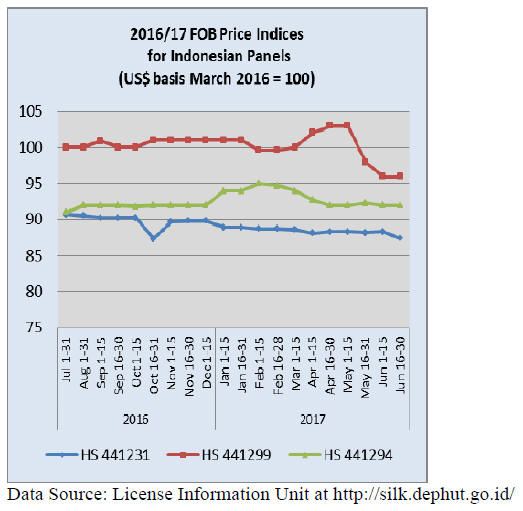
Religious and indigenous leaders discuss
rainforest
protection
Religious and indigenous leaders have met in Norway to
discuss ways to expand protection of tropical rainforests.
Norway hosted the event with participation of Christian,
Muslim, Jewish, Hindu, Buddhist and Daoist
representatives as well as indigenous peoples.
Organizers said the Oslo Interfaith Rainforest
Initiative
was the first to gather religious and indigenous peoples to
seek out common ground to protect forests. They hope to
organize a summit in 2018.
Inspired by Pope Francis’ outspoken stance on global
warming and overdevelopment in his 2015 ‘Laudato Si
Encyclical’, the groundbreaking event was held in Oslo
and backed by Norway’s King Harald V.
See: http://fore.yale.edu/files/Interfaith_Rainforest_Initiative.pdf
6. MYANMAR
MTE planning to resume harvesting
The Myanmar press (Daily Eleven) has quoted Myanma
Timber Enterprise (MTE) Deputy General Manager, Wai
Kyaing, as saying MTE has plans to resume the harvesting
this year after the year-long logging suspension.
According to the media, MTE will harvest 17,000 tons in
the Taninthari Region in south western Myanmar. It has
been reported that trees above the minimum girth limit
have already been marked for felling.
The plan outlined in the press suggests MTE will subcontract
the logging since MTE does not have the
sufficient harvesting capacity. If this is the case then it
would contradict earlier statements that suggested no subcontracting
will be permitted.
Analysts write that it appears sub-contractors will be paid
rather retain some of the logs as payment which was the
previously arrangement. It has been reported that some
community forestry members in the area have written to
the Ministry of Forestry objecting to the planned
harvesting.
EU and Myanmar take proactive steps on timber
legality assurance
The European Timber Trade Federation (ETTF) has issued
a special edition of its Newsletter focused on Myanmar.
This looks closely at issues concerning Myanmar timber
and especially teak exports.
See: http://www.ttf.co.uk/article/special-edition-of-ettfnewsletter-
focused-on-myanmar-now-availa-568.aspx
The publication summarises the recent Environmental
Investigation Agency analysis and outlines the efforts by
the Myanmar authorities, the domestic trade and their
international partners in addressing legality assurance.
The ETTF newsletter special editions says “Alarms have
sounded recently over proof of legality of Myanmar
timber and notably teak exports to the EU. However EU
and Myanmar authorities and timber trade representatives,
including the ETTF, have been liaising closely and are
taking steps to tackle legality assurance deficiencies,
confusion and misinformation.”
In concluding, the ETTF says “while major challenges
remain they have confidence that, with cooperation and
commitment, these can be overcome.”
Tougher penalties in Draft Forest Law
The Draft Forest Law has been published for discussion.
Analysts say the most significant change is the toughening
of penalties (fines and imprisonment). The previous law
remained unchanged since its introduction in 1922.
Foundations for greater Myanmar/India trade
Myanmar is India's gateway to South East Asia and
ASEAN and India is seeking greater economic integration
through its 'Act East' policy (the new government of India
has made its relations with East Asian neighbours a
foreign policy priority).
Myanmar and India share a land border of over 1,600 km
as well-being adjacent across the Bay of Bengal.
Recently Myanmar’s Minister of Commerce Than Myint
and India’s Commerce and Industry Minister, Nirmala
Sitharaman, met to discuss ways to boost trade and
investment.
Sitharaman said that the bilateral trade between the
countries has a much larger untapped potential and she
sought cooperation from Myanmar to actively pursue
enhanced road, sea and air connections between the two
countries.
India's trade with Myanmar grew by 6% percent from
US$2.05 billion in 2015 -16 to US$ 2.18 billion in 2016-
17. Both the sides also agreed to explore opening of two
new trade points at Pangkhuwa and Zoninpuri.

7. INDIA
Record low inflation boost hopes for rate
cut
India’s official wholesale price index for all commodities
(Base: 2011-12=100) for May 2017, released by the Office
of the Economomic Adviser to the government (OEA),
declined by 0.4% to 112.8 (provisional) from 113.2 for the
previous month.
The annual rate of inflation, based on monthly WPI, stood
at 2.17% (provisional) for May 2017 compared to 3.85%
for the previous month. Inflation for this financial year so
far was -0.35% compared to a rate of 2.51% in the
corresponding period last year.
The index for manufactured wood and cork products
declined by 0.5 percent to 130.6 (provisional) from 131.3
(provisional) for the previous month, This says the OEA
was partly due to lower prices of veneer sheets, sawnwood
and particleboard. In addition, food prices fell in May and
this is fueling discontent amongst farmers. The private
sector hopes the record low inflation will lead to an
interest rate cut by Reserve Bank of India.
The press release can be found at:
http://eaindustry.nic.in/cmonthly.pdf
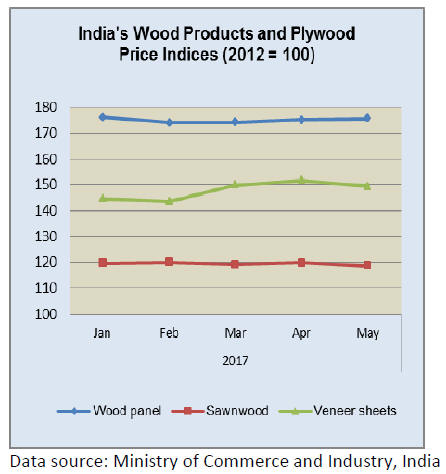
Industry calls for review of GST for panels
The assigned rate of tax under the new Goods and
Services Tax (GST) system has been released. Rates range
from 5% to 28% with essential food items attracting zero
tax.
For wood products falling within HS 44 a GST of 28% has
been set and this has caused widespread dissatisfaction
amongst manufacturers of which some 85% are SMEs.
Currently these SMEs enjoy exemption from excise duty
on sales up to Rs.15 million but when the GST is applied
on 1 July this year the excise duty exemption will be
withdrawn.
Panel manufacturers have made representations through
their State Finance Ministries to the Central Government
requesting a review of the rate from 28% to 12%.
Reconstituted panel makers are arguing that a 28% duty on
particleboard and MDF is too high because these products
are made mostly from plantation wood, wood residues and
agri-residues.
New MDF plant for Andhra Pradesh
The times of India has reported that Rushil Decor Ltd is
planning to build a MDF plant at Atchutapuram, a village
in Visakhapatnam district, located in the Indian state of
Andhra Pradesh. The plant will have a daily capacity of
600 cubic metres.
It is reported that the State Investment Promotion
Board
has granted several concessions for the company under the
state industrialisation policy.
See: http://timesofindia.indiatimes.com/city/visakhapatnam/mdfmanufacturing-
unit-to-be-set-up-in-vizagsoon/
articleshow/57695658.cms
Imported plantation teak
Demand for imported plantation teak logs remains robust.
Shippers have been increasing the volumes available and
have not allowed importers to raise C&F prices even
though freight rates are beginning to climb.
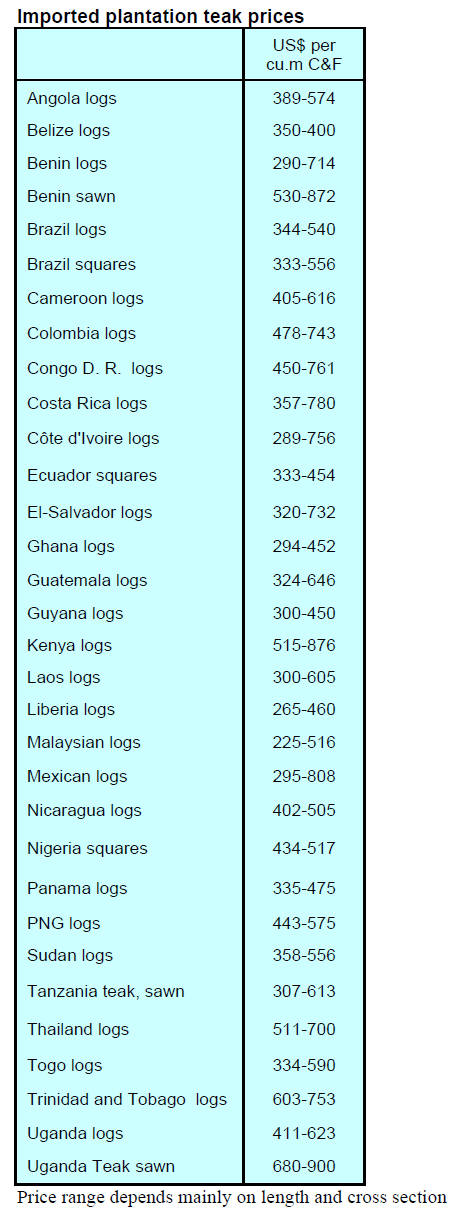
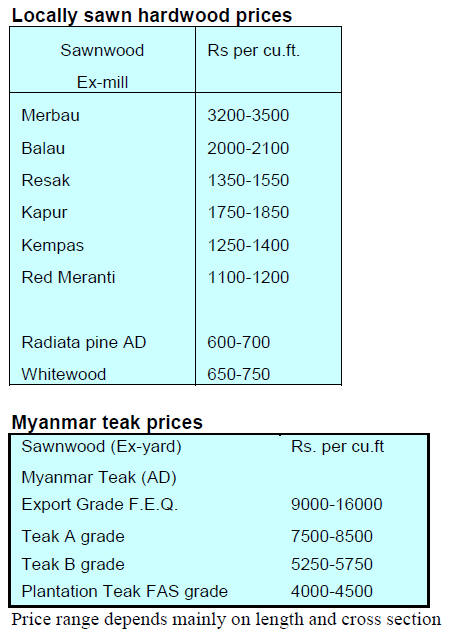
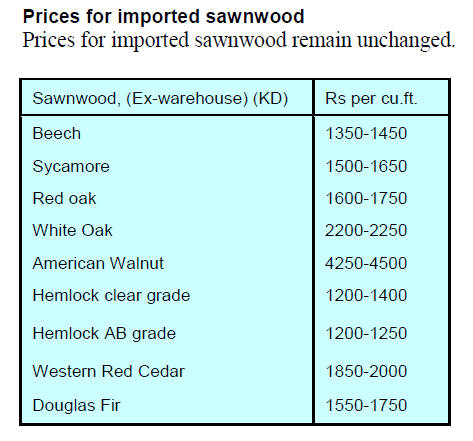
Panel production by SMEs at risk from GST
The impact of the GST on plywood prices will be
significant if the duty rates remain as proposed. At 28%
duty the production of panels by SMEs will be severely
curtailed as many are expected to go out of business.
The impact of the GST on the major plywood
manufacturers will be less severe but with a sharp fall in
production from the SMEs and demand could outstrip
supply. Everyone in the industry is hoping for stability in
the market and anticipates the government will review the
GST on wood based panels.
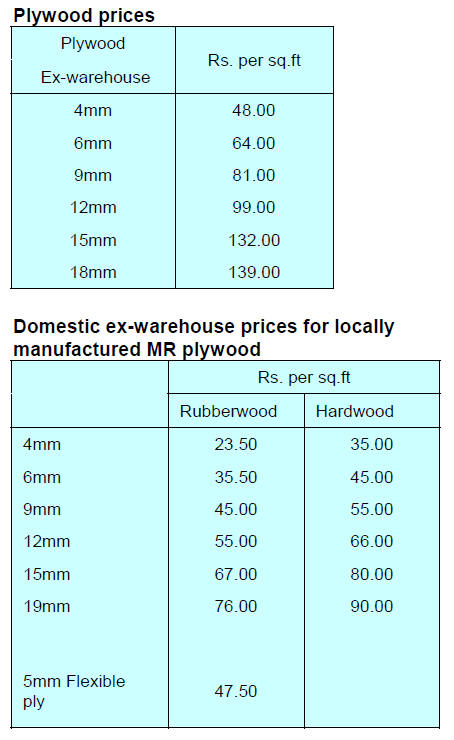
MumbaiWood 2017 to attract pan Asia visitors
India’s furniture market is projected to grow significantly
up to 2019 and the Western Region is expected to offer the
greatest opportunities due to the presence of large number
of industrial hubs and upcoming infrastructure
developments in these regions.
The 3rd MumbaiWood fair will be held 12-14 October
2017 at the Bombay Exhibition Centre, in Goregaon,
Mumbai and is now featured as an international trade
show set to attract pan Asia visitors.
The event will be a unique platform in the western India
for domestic and global brands to showcase furniture
manufacturing and woodworking technologies, raw
materials, fittings, accessories and products.
See: www.mumbai-wood.com/
8. BRAZIL
May inflation, the lowest since 2007
Brazil's economy is forecast to grow 0.4 percent in 2017
after contracting more than 3% in each of the past two
years. In May, government data showed better than
expected job creation as the economy slowly emerges
from its deepest-ever recession.
Inflation in Brazil continued to moderate in May, sliding
below the Central Bank’s target of 4.5%. Inflation has
been slowly falling throughout 2017 which led the Central
Bank to cut interest rates from 11.25% to 10.25% in May
2017. May inflation was the lowest since 2007.
Efforts on sustainable production of high value timber
The Brazilian forestry sector has been engaged in research
on development of forest plantations using native timber
species and in May, Futuro Florestal, a pioneer company
in the field of commercial plantation of high value tropical
timber species organized a workshop on ‘Sustainable
Production of High Value Timber’.
Entrepreneurs, professionals, farmers, researchers and
prospective investors discussed the development of several
species, with emphasis on African mahogany (Khaya spp),
teak (Tectona grandis), guanandi (Callophyllum
brasiliensis) and other hardwood species.
The workshop sought to draw attention to the
opportunities for alternative timbers for sustainable
development of the tropical solid wood production chain.
Experimental plantations of some native and exotic high
value species have been established by Futuro Floresta.
These efforts are in line with commitments made by the
Brazilian government in the Paris Agreement where the
country took on the task of recovering 12 million hectares
of forests by 2030 through forest restoration projects in
legal reserve areas and Permanent Preservation Areas
(APPs).
Another issue discussed was the São Paulo Agribusiness
Expansion Fund (Fundo de Expansão do Agronegócio
Paulista - FEAP). This offers credit lines in addition to
those offered through the Brazilian Development Bank
(BNDES) for forest plantations, agroforestry, agrosilvopastoral
systems and for the recovery of legal reserve
areas.
New protected forest areas in the Amazon
New protected forest areas have been established in the
municipalities of Manoel Urbano (68,537 hectares) and
Feijó (86,582 hectares) in Acre State.
The combined protected area is called the "Complex
Affluent State Forest of Jurupari Seringal (Floresta
Estadual do Afluente do Complexo do Seringal Jurupari)”
and was handed to the government of Acre by the Federal
Government in 2014.
This protected area is part of a series of conservation areas
in Brazil created to protect the soil and other natural
resources and the environment. This new protected area is
considered “temporary” as it will be reviewed in five years
and may be renewed for a further five years to allow for
research to continue.
Socioeconomic studies will be carried out so that
sustainable development and management of the forest is
possible allowing for forest management and extraction of
wood and non-wood forest products within the
conservation unit.
Export round-up
In May 2017 Brazilian exports of wood-based products
(except pulp and paper) increased 23.3% in value
compared to May 2016, from US$ 191.8 million to US$
236.5 million.
Year on year, May pine sawnwood exports increased 41%
in value to US$ 39.5 million. In volume terms, exports
increased 29% over the same period from 152,300 cu.m to
196,000 cu.m.
May 2017 tropical sawnwood exports increased 14% in
volume, from 32,500 cu.m in May 2016 to 37,100 cu.m in
May 2017 while the value of exports increased 6.5% from
US$ 15.4 million to US$ 16.4 million, over the same
period.
Pine plywood exports increased 28% in value in May 2017
compared to levels in May 2016, from US$ 34.5 million to
US$ 43.7 million. In volume terms, exports increased 17%
over the same period, from 131,700 cu.m to 154,000 cu.m.
Tropical plywood, exports also increased in May rising
2.5% in volume terms year on year but the value of
exports fell around 2% from 12,100 cu.m (US$ 5.0
million) in May 2016 to 12,400 cu.m (US$ 4.9 million) in
May 2017.
First rise in furniture exports since 2010
Encouragingly, wooden furniture exports rose from
US$36.2 million in May 2016 to US$42.2 million in May
2017, an almost 17% increase. In the first five months of
this year wooden furniture exports rose 7% year on year
according to the Ministry of Development, Industry and
Foreign Trade (MDIC). Exports by the furniture sector
reached US$242.5 million in this period.
It has been forecast that 2017 wooden furniture exports
will be around 8% higher than last year. If this growth is
achieved it will be the first rise in furniture exports since
2010. Among the main importers are the United States, the
United Kingdom and Argentina.

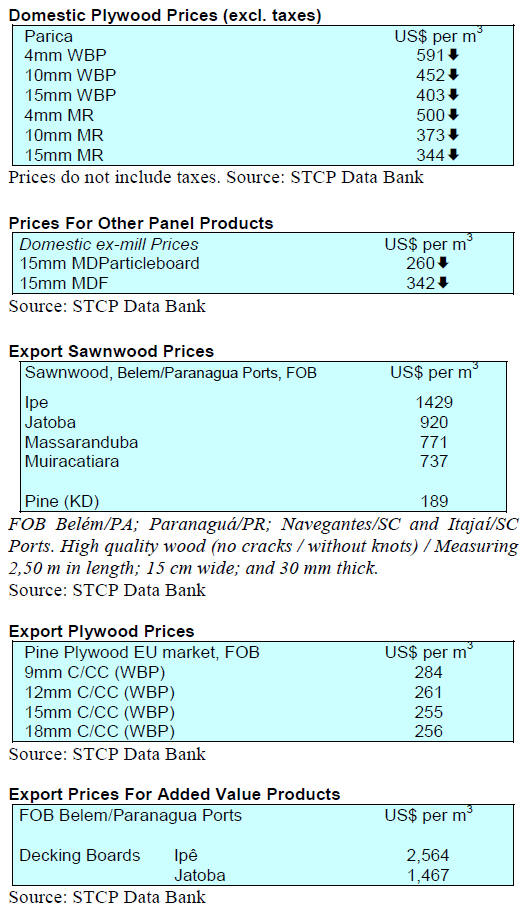
9.
PERU
150,000 hectares of natural forest lost
annually
Each year Peru loses an average of 150,000 hectares of
natural forest due to deforestation caused by migratory
agriculture and subsistence activity that devastates the
Amazon.
According to the National Forestry and Wildlife Service
(Serfor), other causes of deforestation that put the
country's 74 million hectares of forest at risk are illegal
logging, illegal mining and coca leaf cultivation.
John Leigh, Executive Director of Serfor, has pointed out
that deforestation is concentrated in areas coinciding with
the poverty map of the Amazon. Because of this, he said,
it is the State's duty to ensure sustainable use of the
resource for the benefit of the local population. "We have
to give the forest a strong economic value and promote the
wealth that it can produce in its natural sustainably
managed state to avoid a change of land use or illegal
activities” said Leigh.
Elaboration of Forest Plan
In the process of building the National Forestry and
Wildlife Plan, which sets targets up to 2021, Serfor
started the first in a series of meetings with various
stakeholders in the forestry sector. The goal is for this plan
to become a consensual tool to promote the sustainable use
of wild flora and fauna.
Leigh explained that the preparation of this plan will
receive input from various ministries, the private sector,
universities, civil society institutions and other interested
parties.
This plan aims to establish a strategy for implementing
and movimg forward the forestry sector to conserve
biodiversity and at the same time generate and evenly
distribute wealth. A draft document will be ready by year
end, said Leigh.
Results of national forest and wildlife inventory
Serfor and FAO have announced the preliminary results of
the National Forest and Wildlife Inventory in a publication
titled ‘Our Forests in Numbers’.
This document compiles all the information gathered and
analysed at national level since 2013 for 4 sub-populations
or forest eco-zones in Peru: Coast, Sierra, Selva Baja and
Hidromórfica (flooded forest).
The INFFS provides specific data on plant and animal
species and their level of vulnerability. In addition,
information has been collected on the amount of carbon
contained in the biomass of all the eco-zones analysed;
essential data to assess the contribution of forests to the
mitigation of climate change.
The field data compilation for this National Forestry and
Wildlife Inventory began in 2013 and its execution
continues to cover the entire national territory. The INFFS
is a key tool for decision making on the forest resource.
Agrobanco launches ‘Green Bank’ project
The Agricultural Bank (Agrobanco) has launched a "Green
Bank" project with the aim of promoting the sustainable
use of resources and conservation of the environment
through specialised financing for sustainable projects,
good environmental practices and agroforestry.
For more see: http://www.andina.com.pe/Ingles/noticiaagrobanco-
launches-new-project-to-boost-sustainableagriculture-
in-peru-672656.aspx
Green Bank has secured support from the European Union
and the French Development Agency and is part of the
institutional mission and commitment of Peru to reduce
emission of greenhouse gases. The introduction of the
‘Green Bank’ offers an innovative approach to sustainable
business for the creation of economic, social and
environmental value in the projects financed.
Such a project will contribute to food security and
incorporate the need for adaptation and mitigation in
strategies for sustainable agricultural development to
address climate change.
